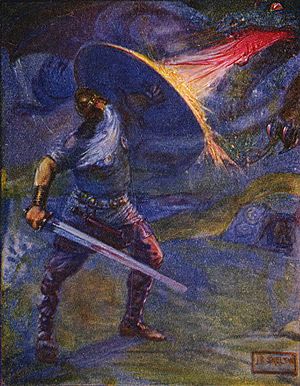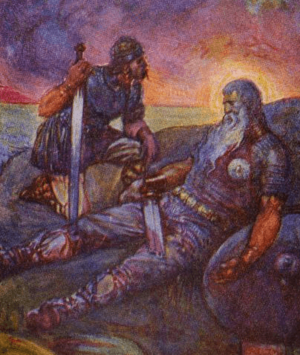The dragon (Beowulf) facts for kids

The final act of the Anglo-Saxon poem Beowulf includes Beowulf's fight with a dragon, the third monster he encounters in the epic. On his return from Heorot, where he killed Grendel and Grendel's mother, Beowulf becomes king of the Geats and rules wisely for fifty years until a slave awakens and angers a dragon by stealing a jewelled cup from its lair. When the angry dragon mercilessly burns the Geats' homes and lands, Beowulf decides to fight and kill the monster personally. He and his thanes climb to the dragon's lair where, upon seeing the beast, the thanes flee in terror, leaving only Wiglaf to battle at Beowulf's side. When the dragon wounds Beowulf fatally, Wiglaf attacks it with his sword, and Beowulf kills it with his dagger.
This depiction indicates the growing importance and stabilization of the modern concept of the dragon within European mythology. Beowulf is the first piece of English literature to present a dragonslayer. Although the Beowulf dragon exhibits many existing motifs common to Germanic tradition, the Beowulf poet was the first to combine features and present a distinctive fire-breathing dragon. The Beowulf dragon was adapted for Middle-earth in J. R. R. Tolkien's The Hobbit (1937), one of the forerunners of modern high fantasy.
The dragon fight, near the end of the poem, is foreshadowed in earlier scenes. The fight with the dragon symbolizes Beowulf's stand against evil and destruction, and, as the hero, he knows that failure will bring destruction to his people after many years of peace. The dragon itself acts as a mock "gold-king"; one who sees attacking Beowulf's kingdom as suitable retribution for the theft of just a single cup. The scene is structured in thirds, ending with the deaths of the dragon and Beowulf.
Contents
Story
After his battles against Grendel's mother and Grendel, Beowulf returns home and becomes king of the Geats. Fifty years pass with Beowulf in charge, when a local dragon is angered when a slave enters its lair and takes a cup from its treasure. The creature attacks the neighboring towns in revenge. Beowulf and a troop of men leave to find the dragon's lair. Beowulf tells his men to stay outside, that this fight is his alone, but the dragon proves strong and mortally wounds Beowulf. Meanwhile, his kinsman Wiglaf scolds the other members of the troop for not going in to help, before coming to Beowulf's aid. He cuts the dragon in the belly to reduce the flames, and Beowulf deals the fatal blow. In his death-speech, Beowulf nominates Wiglaf as his heir and asks for a monument to be built for him on the shoreline.
Background

Beowulf is the oldest extant heroic poem in English and the first to present a dragon slayer. The legend of the dragon-slayer already existed in Norse sagas such as the tale of Sigurd and Fafnir, and the Beowulf poet incorporates motifs and themes common to dragon-lore in the poem. Beowulf is the earliest surviving piece of Anglo-Saxon literature to feature a dragon, and it is possible that the poet had access to similar stories from Germanic legend. Secular Germanic literature and the literature of Christian hagiography featured dragons and dragon fights. Although the dragons of hagiography were less fierce than the dragon in Beowulf, similarities exist in the stories such as presenting the journey to the dragon's lair, cowering spectators, and the sending of messages relaying the outcome of the fight.
The dragon with his hoard is a common motif in early Germanic literature with the story existing to varying extents in the Norse sagas, but it is most notable in the Völsunga saga and in Beowulf. Beowulf preserves existing medieval dragon-lore, most notably in the extended digression recounting the Sigurd/Fafnir tale. Nonetheless, comparative contemporary narratives did not have the complexity and distinctive elements written into Beowulf's dragon scene. Beowulf is a hero who previously killed two monsters. The scene includes extended flashbacks to the Geatish-Swedish wars, a detailed description of the dragon and the dragon-hoard, and ends with intricate funerary imagery.
Beowulf scholar J. R. R. Tolkien considered the dragon in Beowulf to be one of only two real dragons in northern European literature, writing of it, "dragons, real dragons, essential both to the machinery and the ideas of a poem or tale, are actually rare. In northern literature there are only two that are significant ... we have but the dragon of the Völsungs, Fáfnir, and Beowulf's bane." Furthermore, Tolkien believes the Beowulf poet emphasizes the monsters Beowulf fights in the poem and claims the dragon is as much of a plot device as anything. Tolkien expands on Beowulf's dragon in his own fiction, which indicates the lasting impact of the Beowulf poem. Within the plot structure, however, the dragon functions differently in Beowulf than in Tolkien's fiction. The dragon fight ends Beowulf, while Tolkien uses the dragon motif (and the dragon's love for treasure) to trigger a chain of events in The Hobbit.
Characterization
The Beowulf dragon is the earliest example in literature of the typical European dragon and first incidence of a fire-breathing dragon. The Beowulf dragon is described with Old English terms such as draca (dragon), and wyrm (reptile, or serpent), and as a creature with a venomous bite. Also, the Beowulf poet created a dragon with specific traits: a nocturnal, treasure-hoarding, inquisitive, vengeful, fire-breathing creature.
The fire is likely symbolic of the hellfire of the devil, reminiscent of the monster in the Book of Job. In the Septuagint, Job's monster is characterized as a draco, and identified with the devil. Job's dragon would have been accessible to the author of Beowulf, as a Christian symbol of evil, the "great monstrous adversary of God, man and beast alike."
A study of German and Norse texts reveals three typical narratives for the dragonslayer: a fight for the treasure, a battle to save the slayer's people, or a fight to free a woman. The characteristics of Beowulf's dragon appear to be specific to the poem, and the poet may have melded together dragon motifs to create a dragon with specific traits that weave together the complicated plot of the narrative.
Importance
The third act of the poem differs from the first two. In Beowulf's two earlier battles, Grendel and Grendel's mother are characterized as descendants of Cain: "[Grendel] had long lived in the land of monsters / since the creator cast them out / as the kindred of Cain" and seem to be humanoid: in the poet's rendition they can be seen as giants, trolls, or monsters. The dragon, therefore, is a stark contrast to the other two antagonists. Moreover, the dragon is more overtly destructive. He burns vast amounts of territory and the homes of the Geats: "the dragon began to belch out flames / and burn bright homesteads".
Beowulf's fight with the dragon has been described variously as an act of either altruism or recklessness. In contrast with the previous battles, the fight with the dragon occurs in Beowulf's kingdom and ends in defeat, whereas Beowulf fought the other monsters victoriously in a land distant from his home. The dragon fight is foreshadowed with earlier events: Scyld Shefing's funeral and Sigmund's death by dragon, as recounted by a bard in Hrothgar's hall. Beowulf scholar Alexander writes that the dragon fight likely signifies Beowulf's (and by extension, society's) battle against evil. The people's fate depend on the outcome of the fight between the hero and the dragon, and, as a hero, Beowulf must knowingly face death.
Beowulf's eventual death from the dragon presages "warfare, death, and darkness" for his Geats. The dragon's hoard symbolizes the vestige of an older society, now lost to wars and famine, left behind by a survivor of that period. His imagined elegy foreshadows Beowulf's death and elegy to come. Before he faces the dragon, Beowulf thinks of his past: his childhood and wars the Geats endured during that period, foreshadowing the future. At his death, peace in his lands will end, and his people will again suffer a period of war and hardship. An embattled society without "social cohesion" is represented by the avarice of the "dragon jealously guarding its gold hoard",and the elegy for Beowulf becomes an elegy for the entire culture. The dragon's hoard is representative of a people lost and antique, which is juxtaposed against the Geatish people, whose history is new and fleeting. As king of his people, Beowulf defends them against the dragon, and when his thanes desert him, the poem shows the disintegration of a "heroic society" which "depends upon the honouring of mutual obligations between lord and thane".
Wiglaf remains loyal to his king and stays to confront the dragon. The parallel in the story lies with the similarity to Beowulf's hero Sigemund and his companion: Wiglaf is a younger companion to Beowulf and, in his courage, shows himself to be Beowulf's successor. The presence of a companion is seen as a motif in other dragon stories, but the Beowulf poet breaks hagiographic tradition with the hero's suffering (hacking, burning, stabbing) and subsequent death. Moreover, the dragon is vanquished through Wiglaf's actions: although Beowulf dies fighting the dragon, the dragon dies at the hand of the companion.
The dragon battle is structured in thirds: the preparation for the battle, the events prior to the battle, and the battle itself. Wiglaf kills the dragon halfway through the scene, Beowulf's death occurs "after two-thirds" of the scene, and the dragon attacks Beowulf three times. Ultimately, as Tolkien writes in Beowulf: The Monsters and the Critics (1936), the death by dragon "is the right end for Beowulf," for he claims, "a man can but die upon his death-day".
Legacy
In From Homer to Harry Potter: A Handbook on Myth and Fantasy, Matthew Dickerson and David O'Hara argue that the Beowulf poet added the figure of the dragon to "the pot...that is ladled out of by most modern fantasy writers"; they argued that both numerous works with villainous dragons, as well as literature with benign dragons like the My Father's Dragon books and the Pern series by Anne McCaffrey, were influenced by Beowulf's dragon. Dickerson and O'Hara further elaborated that through its dragon, Beowulf turned the "notion of having a monstrous evil (and not mere human foes) as the enemy" into "a hallmark of modern fantasy" present in C. S. Lewis' Narnia books, Ursula K. Le Guin's Earthsea books, and the Thomas Covenant series by Stephen Donaldson.
J. R. R. Tolkien used the dragon story of Beowulf as a template for Smaug of The Hobbit; in each case, the dragon awakens upon the hoard being disturbed by one stealing a chalice and goes into a wrathful rampage until slain by another person. Aia Hussein of the National Endowment for the Humanities has written that the fight between Harry Potter and the Hungarian Horntail in Harry Potter and the Goblet of Fire (2000) by J. K. Rowling was influenced by the confrontation between the dragon and the title character in Beowulf.
In the 2007 film version, the dragon is Grendel's younger half-brother as he's the son of the latter's mother and Beowulf whom he ironically ends up killing in the end of the movie.


